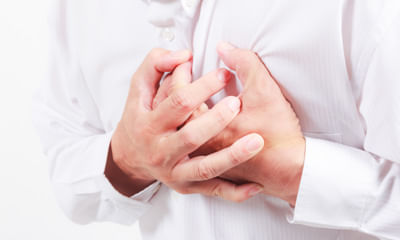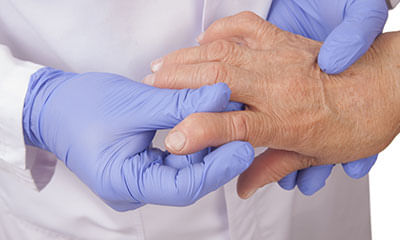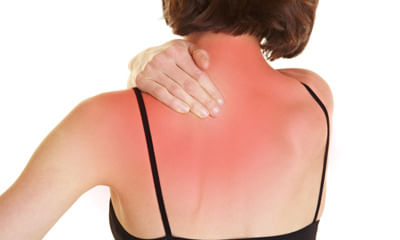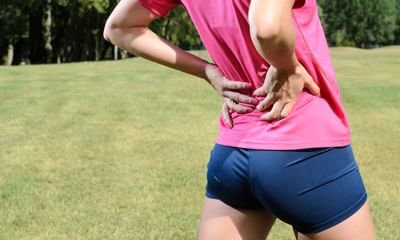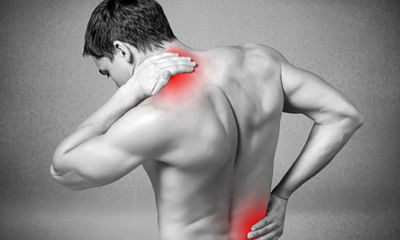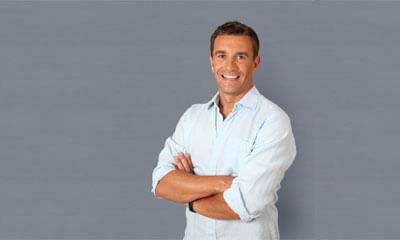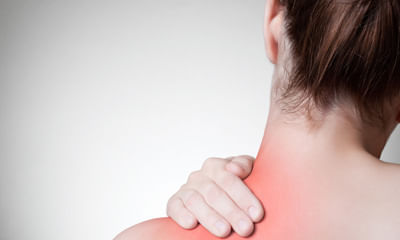Symptoms Of Weak Lungs
What kind of doctor should I see for a chest rib pain my rib to the sternum and rib to the backbone joints hurt early in ...
Ask Free Question
Belly breathing exercise (diaphragmatic breathing) lie on your back with your knees up and completely relax. Place one hand on your chest and the other on your belly. Breath in through your nose taking in as much air as you comfortably can and allow the hand on your belly to raise higher than the one on the chest (this shows that air is being pulled into the base of your lungs). Hold for up to 7 seconds and then slowly breathe out through the mouth for up to 8 seconds (contract your belly muscles to fully release as much air as possible). Try and perform a set of 5 of these every 10-15 seconds. You can perform this 5-10 times per day. Seated belly breathing exercise (diaphragmatic breathing) whilst seated with good posture place one hand on your chest and the other on your belly. Breath in through your nose taking in as much air as you comfortably can and allow the hand on your belly to raise higher than the one on the chest (this shows that air is being pulled into the base of your lungs). Hold for up to 7 seconds and then slowly breathe out through the mouth for up to 8 seconds (contract your belly muscles to fully release as much air as possible). Try and perform a set of 5 of these every 10-15 seconds. You can perform this 5-10 times per day. Myofascial self-massage for chest pain myofascial release techniques can help you release tightness in your chest area, which relaxes your chest muscles. Relieves tender spots in your thoracic spine stand with your back to the wall. Place the ball 08 to the side of your spine, on a line with the bottom of your shoulder blade. Roll up along the area between your spine and your shoulder blade, until you get to the junction between your shoulder and neck. Chest stretching exercises: mobilizes your thoracic spine lie on your side on the floor. Stretch out the lower leg and place the top knee onto the blackroll® at a 90-degree angle. Activation and strengthening exercises for chest pain when you’ve worked to tackle the symptoms of your chest tightness, you should work on your posture. That’s because your chest pain probably started from poor posture or muscle imbalances. With the following exercises, you’ll therefore train the muscles that tend to get weaker. Chest pain exercise: activates your shoulder blades secure the multi band in front of you at hip height and hold one of the loops. With the leg from the same side, lower down onto the knee, placing it directly below your hip. Stretches upper back side-bend stretch stand up straight with your arms on your sides and side bend your upper back only as far as comfortable to one side, hold for 3 seconds and then and repeat to the other side. Concentrate your stretch through your upper back. Perform 10 stretches, three times per day. Horizontal rolled up towel upper back stretch (thoracic mobilisation) place a rolled up towel horizontally under your upper back and rest. Allow the weight of your head and neck and low back to create a gentle stretch through the vertebrae of your upper back. Enhance the stretch by taking deep breaths. Perform this stretch for 3-10 minutes.
My mother have rheumatoid arthritis since 5 year. Now she get unbearable join pain. In last 6 month she has medical hist ...
Ask Free Question
The "normal" range (or negative test result) for rheumatoid factor is less than 14 iu/ml. Any result with values 14 iu/ml or above is considered abnormally high, elevated, or positive. Treatmentthere is no cure for rheumatoid arthritis. But clinical studies indicate that remission of symptoms is more likely when treatment begins early with medications known as disease-modifying antirheumatic drugs (dmards). Medicationsthe types of medications recommended by your doctor will depend on the severity of your symptoms and how long you've had rheumatoid arthritis. •nsaids. Nonsteroidal anti-inflammatory drugs (nsaids) can relieve pain and reduce inflammation. Over-the-counter nsaids include ibuprofen (advil, motrin ib) and naproxen sodium (aleve). Stronger nsaids are available by prescription. Side effects may include stomach irritation, heart problems and kidney damage. •steroids. Corticosteroid medications, such as prednisone, reduce inflammation and pain and slow joint damage. Side effects may include thinning of bones, weight gain and diabetes. Doctors often prescribe a corticosteroid to relieve acute symptoms, with the goal of gradually tapering off the medication. •disease-modifying antirheumatic drugs (dmards). These drugs can slow the progression of rheumatoid arthritis and save the joints and other tissues from permanent damage. Common dmards include methotrexate (trexall, otrexup, others), leflunomide (arava), hydroxychloroquine (plaquenil) and sulfasalazine (azulfidine). Side effects vary but may include liver damage, bone marrow suppression and severe lung infections. •biologic agents. Also known as biologic response modifiers, this newer class of dmards includes abatacept (orencia), adalimumab (humira), anakinra (kineret), baricitinib (olumiant), certolizumab (cimzia), etanercept (enbrel), golimumab (simponi), infliximab (remicade), rituximab (rituxan), sarilumab (kevzara), tocilizumab (actemra) and tofacitinib (xeljanz). These drugs can target parts of the immune system that trigger inflammation that causes joint and tissue damage. These types of drugs also increase the risk of infections. In people with rheumatoid arthritis, higher doses of tofacitinib can increase the risk of blood clots in the lungs. Biologic dmards are usually most effective when paired with a nonbiologic dmard, such as methotrexate. Therapy your doctor may send you to a physical or occupational therapist who can teach you exercises to help keep your joints flexible. The therapist may also suggest new ways to do daily tasks, which will be easier on your joints. For example, you may want to pick up an object using your forearms. Assistive devices can make it easier to avoid stressing your painful joints. For instance, a kitchen knife equipped with a hand grip helps protect your finger and wrist joints. Certain tools, such as buttonhooks, can make it easier to get dressed. Catalogs and medical supply stores are good places to look for ideas. Surgeryif medications fail to prevent or slow joint damage, you and your doctor may consider surgery to repair damaged joints. Surgery may help restore your ability to use your joint. It can also reduce pain and improve function. Rheumatoid arthritis surgery may involve one or more of the following procedures: •synovectomy. Surgery to remove the inflamed lining of the joint (synovium) can be performed on knees, elbows, wrists, fingers and hips. •tendon repair. Inflammation and joint damage may cause tendons around your joint to loosen or rupture. Your surgeon may be able to repair the tendons around your joint. •joint fusion. Surgically fusing a joint may be recommended to stabilize or realign a joint and for pain relief when a joint replacement isn't an option. •total joint replacement. During joint replacement surgery, your surgeon removes the damaged parts of your joint and inserts a prosthesis made of metal and plastic. Surgery carries a risk of bleeding, infection and pain. Discuss the benefits and risks with your doctor. Rheumatoid arthritis multiple joint pains / early morning painit is called as rheumatic arthritis. Treatment goals •to protect the joint from further damages. •provide pin relief. •prevent deformity and disabilities. •increase functional capacity. •improve flexibility and strength. •encourage regular exercise. •improve general fitness. Physiotherapy modalities - hot/cold applications- electrical stimulation- hydrotherapy and spa therapy rehabilitation treatment technique - rest and splinting - compression gloves - assistive devices and adaptive equipment - massage therapy - therapeutic exercise - patient education assistive devices and adaptive equipment occupational therapy improves functional ability in patients with ra. Occupational therapy interventions such as assistive devices and adaptive equipments have beneficial effects on joint protection and energy conservation in arthritic patients.Assistive devices are used in order to reduce functional deficits, to diminish pain, and to keep patients' independence and self-efficiency. Loading over the hip joint may be reduced by 50% by holding a cane. In fact, most of these instruments are originally designed for patients with neurologic deficits; therefore, certain adaptations may be needed for them to be used in patients with arthritis. Elevated toilet seats, widened gripping handles, arrangements related with bathrooms, etc. Might all facilitate the daily life. The procedures needed to increase compliance of the patient with the environment and to increase functional independence are +mainly determined by the occupational therapist. Massage therapy that improves flexibility, enhances a feeling of connection with other treatment modalities, improves general well being, and can help to diminish swelling of inflamed joints. Massage is found to be effective on depression, anxiety, mood, and pain. Therapeutic exercise every joint should be moved in the rom at least once per day in order to prevent contracture. In the case of acutely inflamed joints, isometric exercises provide adequate muscle tone without exacerbation of clinical disease activity. Moderate contractures should be held for 6 seconds and repeated 5–10 times each day. Dynamic exercise therapy in improving joint mobility, muscle strength, aerobic capacity and daily functioning in patients with rheumatoid arthritis (ra). Finally, in chronic stage with inactive arthritis, conditioning exercises such as swimming, walking, and cycling with adequate resting periods are recommended. They increase muscle endurance and aerobic capacity and improve functions of the patient in general, and they also make the patient feel better. It might be due to lack of blood circulation which is the reason for you to have scrotum pain / back pain. You have to do basic aerobic exercises for you to become fit and also to maintain the blood circulation and tone. Patient education in patients with ra, sociopsychological factors affecting the disease process such as poor social relations, disturbance of communication with the environment, and unhappiness and depression at work are commonly encountered. The treatment of rheumatic diseases should provide education and information to their patients about their condition and the various physical therapy and rehabilitative options that are available to improve their quality of life. Passive treatments for rheumatoid arthritis •cold therapy reduces circulation, which ultimately decreases swelling. For example, a cold compress may be placed on the painful area. •cold therapy in acute phase •dosage 10-20mints/1-2 times a day. •heat therapy eases muscle tension and gets blood to flow more quickly to the painful area. For example, a moist, warm cloth may be used to promote circulation. •heat therapy in chronic phase •dosage 20-30mints/1-2 times a day. •hydrotherapy involves reducing your ra-related pain and other symptoms with water. With hydrotherapy, you will be submerged in warm water to relieve your symptoms. •massage can help reduce muscle tension and promote good circulation. It's also a fantastic way to help you manage stress (especially important for people with rheumatoid arthritis). •transcutaneous electrical nerve stimulation (tens) works by blocking pain signals from getting to your spinal cord. It also helps decrease muscle spasms. •tens short term pain relief (6 to 18 hrs) •ultrasound creates warmth using sound waves, whichenchanes circulation and decreases joint pain, inflammation, and stiffness. Exercise for acute phase: •preformed exercise at least once a day. •general assisted movement through normal range (joint mobilisation). •isometric-“static movements” helps to maintain muscle tone without increasing inflammation. Exercise for the chronic phase: •can progress the above exercise to include use of light resistance. •postural/core stability exercises. •swimming/walking/cycling to maintain cardiovascular fitness. •gentle stretch for areas that become tight, such as knees &calves. Regular exercises: •maintaing muscle strength is important for joint stability & preventing injury. •muscles can become weak following reduced activity. •pain signals from yours nerves and swelling can both inhibits muscles. •muscle length can be affected by prolonged positions immobilization and tightness can limit daily activities. Alternative therapies: •thi chi. •musical therapy. •yoga therapy. •relaxation techniques. •pilates. Active treatments for rheumatoid arthritis •flexibility and strengthening exercises improve your range of motion and help you build muscle strength. Yoga and pilates are flexibility and strengthening exercises. •low-impact aerobic exercise is gentle but effective at helping you manage rheumatoid arthritis symptoms. Light walking is an example of this type of exercise. Your physical therapist will let you know how often to do these exercises. For example, you may need to do a few specific exercises 3 times a day, or your physical therapist may recommend a routine that incorporates 30 minutes of low-impact aerobic exercise a day and 30 minutes of strengthening exercises every other day. If your pain is more in the proximal joints, ie.in the upper limbs if the pain is present in the fingers/wrist and in the lower limbs it the pain is present in the toes/ ankle, then we shall definitely say it is rheumatic arthritis. Wear elbow brace and wrist brace which will make her to feel warm and that will make the joints become firm. Hot water fermentation will helpknee cap will also help to prevent the damaged cartilagesif your pain is more in the distal joints, ie. In the upper limbs if the pain is present in the fingers/wrist and in the lower limbs it the pain is present in the toes/ ankle, then we shall definitely say it is rheumatic arthritis. If your proximal joints (ie. Shoulder, hip & knee has pain) then you can pour hot (warm) water in that area to reduce the inflammation. If you have pain in the distal joints ie. Wrist, fingers, ankle, toes then you can wear either elbow brace or wrist brace which will help you to feel warm and very protective. And also immerse the distal joints in the hot water tub which will help you to reduce the pain. Knee pain during driving or watching movie. It might due to lack of movements in the knee while the joints are immobilized during driving and while watching movies. It is important that you need to have movements in and around the knee so that the blood flow will not be disturbed.
I am a 13 year old female with weak bones (scoliosis). I was sitting on my foot and when I got up, my toe was hanging do ...
Ask Free Question
Scoliosis is a sideways curvature of the spine that most often is diagnosed in adolescents. While scoliosis can occur in people with conditions such as cerebral palsy and muscular dystrophy, the cause of most childhood scoliosis is unknown. Most cases of scoliosis are mild, but some curves worsen as children grow. Severe scoliosis can be disabling. An especially severe spinal curve can reduce the amount of space within the chest, making it difficult for the lungs to function properly. The angle of the curve may be small, large, or somewhere in between. But anything that measures more than 10 degrees on an x-ray is considered scoliosis. Children who have mild scoliosis are monitored closely, usually with x-rays, to see if the curve is getting worse. In many cases, no treatment is necessary. Some children will need to wear a brace to stop the curve from worsening. Others may need surgery to straighten severe curves. Signs and symptoms of scoliosis may include: uneven shoulders one shoulder blade that appears more prominent than the other uneven waist one hip higher than the other one side of the rib cage jutting forward a prominence on one side of the back when bending forward complications breathing problems-in severe scoliosis, the rib cage may press against the lungs, making it more difficult to breathe. Back stiffness pain and numbness in your legs (from pinched nerves) fatigue due to muscle strain appearance-noticeable changes — including uneven hips and shoulders, prominent ribs, and a shift of the waist and trunk to the side. Individuals with scoliosis often become self-conscious about their appearance. Full-time braces:•milwaukee brace. •boston brace. •wilmington brace. Nighttime braces: •charleston bending brace. Treatment braces- if your child's bones are still growing and he or she has moderate scoliosis, your doctor may recommend a brace. Wearing a brace won't cure scoliosis or reverse the curve, but it usually prevents the curve from getting worse. The most common type of brace is made of plastic and is contoured to conform to the body. This brace is almost invisible under the clothes, as it fits under the arms and around the rib cage, lower back and hips. Most braces are worn between 13 and 16 hours a day. A brace's effectiveness increases with the number of hours a day it's worn. Children who wear braces can usually participate in most activities and have few restrictions. Exercises benefits of scoliosis exercises •reduce spinal curvature. •improve brain and muscle coordination. •slow down or stop scoliosis progression. •stabilize and reduce existing curvature. •reduce the need for surgery or invasive bracing. Slowly move your neck, arms, and mid-torso in the opposite direction. Hold this pose for 5 seconds and then slowly return to the starting position. Do this on the opposite side too. Repeat this 10 times. Hold the pose for 2 seconds. Precaution do not twist too much or for too long. Exercises to avoid •exercises that require you to lean or bend forward. •exercises that require you to overextend or curve your lower back. •football or competitive swimming. •sleeping on your belly. •playing or jumping on the trampoline. •running for long distances. •lifting or carrying heavy objects. •heavy weightlifting at the gym. Flat foot that might trigger the pain always and however we treat that may not help. Hot water fermentation will help and that can be done by immersing the foot in hot water. Wear mcr chappals.
Hello doctor's this is aakanksha, 17 year/f doctor I feel pain when I take deep breath down to the lungs and my back als ...
Ask Free Question
It's spine thoracic stiffness. Visit physiotherapy centre start treatment it will cure otherwise mri of spine. Smtime bad posture and long sitting of computer can happen.
Specialist for muscular dystrophy for 7 years old boy my son is seven years old he is not able to stand from sitting pos ...
Ask Free Question
Muscular dystrophy is a group of rare inherited muscle disease in which muscle fibers are unusually susceptible to damage. Muscles, primarily voluntary muscle ,become progressively weaker. In the late stage of muscular dystrophy ,fat and connective tissue often replace muscle fibers. In some type of muscular dystrophy, heart muscle, other involuntary muscles, and other organs are affected. Although there's no cure for any form of muscular dystrophy, treatment for some forms of the disease can help extend the time a person with the disease can remain mobile and help with heart and lung muscle strength. Trials of new therapies are ongoing. Unfortunately, there isn't anything you can do to prevent getting muscular dystrophy. If you have the disease, these steps can help you enjoy a better quality of life: eat a healthy diet to prevent malnutrition. Researchers are still looking for a way to cure muscular dystrophy. Disease symptoms get worse over time, but these treatments can help: physical and occupational therapies strengthen and stretch muscles. These therapies can help you maintain function and range of motion. Speech therapy helps those who have problems swallowing. Corticosteroids, such as prednisone and deflazacort, may slow disease progression. Surgery relieves tension on contracted muscles and corrects spine curvature (scoliosis). Heart assist devices, such as pacemakers, treat heart rhythm problems and heart failure. Medical devices, such as walkers and wheelchairs, can improve mobility and prevent falls. Respiratory care, such as cough-assist devices and respirators, aid breathing.
Adenocarcinoma stage 4 b in lung, found in usg, multiple calculi in lumen symptoms. Vomiting with white foam. No pain ti ...
Ask Free Question
The patient is quite critical to be very frank. And you should be in touch with the oncologist/oncosurgeon. He/she will the best person to guide you in this scenario.
Adenocarcinoma stage 4 b in lung, found in usg, multiple calculi in lumen symptoms. Vomiting with white foam. No pain ti ...
Ask Free Question
Need to undergo few molecular test on biopsy tissue if feasible retrieve tissue wax block from biopsy lab and send for analysis you can video consult also for test and then see there are better drug available if mutation testing is positivw.
I am suffering from tb since 7th nov, but I feel weak ,how to take precautions and diet ,3 tab one time take in morning ...
Ask Free Question
I am sorry to hear about your concern but will be happy to assist you. People who develop tb disease have symptoms based on where in the body the tb bacteria are growing. Tb bacteria usually grow in the lungs and symptoms can include: bad cough that last 3 weeks or longer, pain in the chest, coughing up blood or sputum, weakness/fatigue, weight loss, chills, fever and night sweats. Let's connect over a call so that we can discuss your concern in details and make a suitable treatment plan for you.
June 24 I start not to feel well and I decide that I should put myself into self-isolation and by monday I start to feel ...
Ask Free Question
Hi-lybrate-user covid19 is a new viral infection and we do not know much about it. It was believed that it mainly affects lungs. But increasingly evidence is accumulating that it is a multiorgan disease and not confined to lungs. We know that only known way to fight the problem is to increase immunity-by taking mixed fresh food, 2 boiled eggs daily, warm milk to which a pinch of turmeric is added, warm salt water gargling daily twice, one becosules-z cap daily, drink plenty of boiled and cooled water so that you pass more than one liter of urine. I am of the view that you have recovered almost. Last but not the least -your determination/boldness to fight the disease is utmost importance. Wishing quick recovery.
Hello, 3 weeks ago I was sitting on my desk and suddenly I felt tingling and numbing in my left arm started from my left ...
Ask Free Question
1.no alcohol 2. Reduce body wt if over wt 3. No smoking/ tobacco/drugs/ avoid pollution 4. Diet - no ghee/ butter, have mix of vegetable oils - mustard, til, ground nut, olive oil, have more green vegetables and fruits, have whole grain atta, no fried. Fast. Spicy / processed/ junk food. Less sugar, potato, rice 5. 30 mts brisk walk daily 6. Deep breathing exercise for 10 mts daily 7. Meditation daily for 10 mts. 6-8 hrs of sleep at night 8. Expose your body to sun for 15-20 mts daily after some oil massage to get vit d. 9. Take more water medicine can not be advised for open question ,for medicine and further advise contact on private consults. Good luck.

